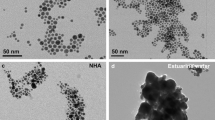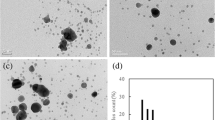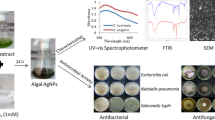Abstract
Silver nanomaterials are widely used in commercial products, because the released silver nanomaterials be worried about ecotoxicity of freshwater organisms in environment. We have focused on reducing nanotoxicity using environmentally-friendly biological process by hydra cells. The hydra has a strong regenerative capacity about toxic chemicals, excellent adhesion and aggregation of hydra cells through self-organization during hydra regeneration stages. The hydra regeneration test examined two types of silver nanocolloids (Ag NCs) and silver nanotubes (Ag NTs) at concentrations of 5, 10, 50, 100 mg/L, respectively. In addition, we compared to the antimicrobial effects against E. coli (Gram-negative) and S. aureus (Gram-positive) bacteria by Ag NCs, Ag NTs and the Ag NCs including hydra cells. The aim of this study is not only to investigate the reducing nanotoxic effects in bacteria by the mixed silver nanomaterials including hydra cells but also to compare the nanotoxicity between Ag NCs and Ag NTs. Our results suggest that the silver nanomaterials including hydra cells can be reduced to nanotoxic effects in both E. coli (Gram-negative) and S. aureus (Gram-positive) bacteria. Because, the mixed Ag NCs including hydra cell were coiled around Ag NCs, which may inhibited by Ag NCs aggregations and the blocked silver ions. Furthermore, the shapes of silver nanomaterials are different nanotoxic effects according to the species sensitivity between hydra and bacteria.
Similar content being viewed by others
References
Kishimoto, Y., Murate, M. & Sugiyama, T. Hydra regeneration from recombined ectodermal and endodermal tissue. I. Epibolic ectodermal spreading is driven by cell intercalation. J Cell Sci 109:763–772 (1996).
Murate, M. et al. Hydra regeneration from recombined ectodermal and endodermal tissue II. Differential stability in the ectodermal and endodermal epithelial organization. J Cell Sci 110:1919–1934 (1997).
Holstein, T. W. A view to kill. BMC Biol 10:1–4 (2012).
Technau, U. & Holstein, T. W. Cell sorting during the regeneration of Hydra from reaggregated cells. Dev Biol 151:117–127 (1992).
Sato-Maeda, M. & Tashiro, H. Development of oriented motion in regenerating hydra cell aggregates. Zoolog Sci 16:327–334 (1999).
Rieu, J. P., Upadhyaya, A., Glazier, J. A., Ouchi, N. B. & Sawada, Y. Diffusion and deformations of single hydra cells in cellular aggregates. Biophys J 79:1903–1914 (2000).
Technau, U. et al. Parameters of self-organization in Hydra aggregates. Proc Natl Acad Sci USA 97:12127–12131 (2000).
Park, H. G. & Yeo, M. K. The toxicity of triclosan, bisphenol A, bisphenol A diglycidyl ether to the regeneration of cnidarian, Hydra magnipapillata. Mol Cell Toxicol 8:209–216 (2012).
Hydra anatomy, Available online at www.williamhogarth. de/HydraAnatomy3.jpg
Campbell, N. A. et al. Biology, 8th ED (Pearson Education, Inc., publishing as Pearson Benjamin Cummings, 2008).
Kim, J. S. et al. Antimicrobial effects of silver nanoparticles. Nanomedicine 3:95–101 (2007).
Choi, O. K. et al. The inhibitory effects of silver nanoparticles, silver ions, and silver chloride colloids on microbial growth. Water Res 42:3066–3074 (2008).
Choi, O. K. et al. Role of sulfide and ligand strength in controlling nanosilver toxicity. Water Res 43:1879–1886 (2009).
Dror-Ehre, A., Mamane, H., Belenkova, T., Markovich, G. & Adin, A. Silver nanoparticle-E. coli colloidal interaction in water and effect on E. coli survival. J Colloid Interface Sci 339:521–526 (2009).
Rai, M., Yadav, A. & Gade, A. Silver nanoparticles as a new generation of antimicrobials. Biotechnol Adv 27:76–83 (2009).
Li, Q. et al. Antimicrobial nanomaterials for water disinfection and microbial control: potential applications and implications. Water Res 42:4591–4602 (2008).
Gopinath, P. et al. Signaling gene cascade in silver nanoparticle induced apoptosis. Colloids Surf B Biointerfaces 77:240–245 (2010).
Prabhu, S. & Poulose, E. K. Silver nanoparticles: mechanism of antimicrobial action, synthesis, medical applications, and toxicity effects. Int Nano Lett 2:1–10 (2012).
Beach, M. J. & Pascoe, D. The role of Hydra vulgaris (Pallas) in assessing the toxicity of freshwater pollutants. Warter Res 32:101–106 (1998).
Karntanut, W. & Pascoe, D. A comparison of methods for measuring acute toxicity to Hydra vulgaris. Chemosphere 41:1543–1548 (2000).
Karntanut, W. & Pascoe, D. The toxicity of copper, cadmium and zinc to four different Hydra (Cnidaria: Hydrozoa). Chemosphere 47:1059–1064 (2002).
Quinn, B., Gagné, F. & Blaise, C. An investigation into the acute and chronic toxicity of eleven pharmaceuticals (and their solvents) found in wastewater effluent on the cnidarian, Hydra attenuata. Sci Total Environ 389:306–314 (2008).
Quinn, B., Gagné, F. & Blaise, C. Evaluation of the acute, chronic and teratogenic effects of a mixture of eleven pharmaceuticals on the cnidarian, Hydra attenuata. Sci Total Environ 407:1072–1079 (2009).
Blaise, C., Gagné, F., Férard, J. F. & Eullaffroy, P. Ecotoxicity of selected nano-materials to aquatic organisms. Environ Toxicol 23:591–598 (2008).
Yeo, M. K. & Kang, M. The effect of nano-scale Zndoped TiO2 and pure TiO2 particles on Hydra magnipapillata. Mol Cell Toxicol 6:9–17 (2010).
Quinn, B., Gagné, F. & Blaise, C. Hydra, a model system for environmental studies. Int J Dev Biol 56:613–625 (2012).
Pan, H. C., Yang, H. Q., Zhao, F. X. & Qian, X. C. Molecular cloning, sequence analysis, prokaryotic expression, and function prediction of foot-specific peroxidase in Hydra magnipapillata Chinese strain. Genet Mol Res 13:6610–6622 (2014).
Marchesano, V. et al. Imaging inward and outward trafficking of gold nanoparticles in whole animals. ACS Nano 7:2431–2442 (2013).
Takaku, Y., Hariyama, T. & Fujisawa, T. Motility of endodermal epithelial cells plays a major role in reorganizing the two epithelial layers in Hydra. Mech Dev 122:109–122 (2005).
Kasahara, S. & Bosch, T. C. Enhanced antibacterial activity in Hydra polyps lacking nerve cells. Dev Comp Immunol 27:79–85 (2003).
Jung, S. et al. Hydramacin-1, structure and antibacterial activity of a protein from the basal metazoan Hydra. J Biol Chem 284:1896–1905 (2009).
Augustin, R. et al. Activity of the novel peptide arminin against multi resistant human pathogens shows the considerable potential of phylogenetically ancient organisms as drug sources. Antimicrob Agents Chemother 53:5245–5250 (2009).
Augustin, R., Fraune, S. & Bosch, T. C. How Hydra senses and destroys microbes. Semin Immunol 22:54–58 (2010).
Gottenbos, B., Grijpma, D. W., van der Mei, H. C., Feijen, J. & Busscher, H. J. Antimicrobial effects of positively charged surfaces on adhering gram-positive and gram-negative bacteria. J Antimicrob Chemother 48:7–13 (2001).
Abbaszadegan, A. et al. The effect of charge at the surface of silver nanoparticles on antimicrobial activity against gram-positive and gram-negative bacteria: A preliminary study. J Nanomater 2015:1–8 (2015).
Arakha, M., Saleem, M., Mallick, B. C. & Jha, S. The effects of interfacial potential on antimicrobial propensity of ZnO nanoparticle. Sci Rep 5:1–10 (2015).
Morones, J. R. et al. The bactericidal effect of silver nanoparticles. Nanotechnology 16:2346–2353 (2005).
Sugiyama, T. & Fujisawa, T. Genetic analysis of developmental mechanisms in Hydra. III. Characterization of a regeneration deficient strain. J Embryol Exp Morphol 42:65–77 (1977).
Bossert, P. & Galliot, B. How to use Hydra as a model system to teach biology in the classroom. Int J Dev Biol 56:637–652 (2012).
Yum, S. et al. Hydra, a candidate for an alternative model in environmental genomics. Mol Cell Toxicol 10:339–346 (2014).
Wilby, O. K. “The Hydra regeneration assay,” in Proceedings of workshop organized by Association francaise de teratologie. 108–124 (1988).
Sadeghi, B. et al. Comparison of the anti-bacterial activity on the nanosilver shapes: Nanoparticles, nanorods and nanoplates. Adv Powder Technol 23:22–26 (2012).
Pal, S., Tak, Y. K. & Song, J. M. Does the antibacterial activity of silver nanoparticles depend on the shape of the nanoparticle? A study of the gram-negative bacterium Escherichia coli. Appl Environ Microbiol 73:1712–1720 (2007).
Wu, P., Imlay, J. A. & Shang, J. K. Mechanism of Escherichia coli inactivation on palladium-modified nitrogen-doped titanium dioxide. Biomaterials 31:7526–7533 (2010).
Author information
Authors and Affiliations
Corresponding author
Rights and permissions
About this article
Cite this article
Park, HG., Yeo, MK. Toxic effects against bacteria of silver nanocolloids and silver nanotubes in the presence of hydra cells. Mol. Cell. Toxicol. 13, 37–47 (2017). https://doi.org/10.1007/s13273-017-0004-y
Received:
Accepted:
Published:
Issue Date:
DOI: https://doi.org/10.1007/s13273-017-0004-y




